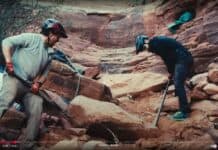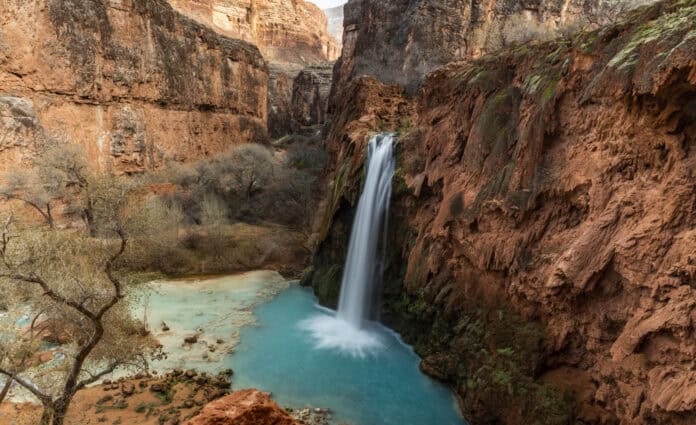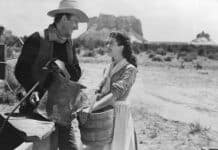The Sedona Public Library will be holding its “An Evening with Kevin Fedarko” fundraiser on Saturday, Oct. 19, at 6:30 p.m. at the Sedona Performing Arts Center. Fedarko will talk about hiking the length of the Grand Canyon over 75 days split up over a 14-month period with his friend and collaborator Peter McBride, a National Geographic photographer and filmmaker.
VIP ticket holders for this event will also receive a ticket to a screening of McBride’s accompanying documentary “Into the Canyon” at the Mary D. Fisher Theatre the following week.
“It’s a story about an incredibly arduous journey through a vertical wilderness that has no trail linking the east and the west ends of the canyon,” Fedarko said. “[It’s] also a journey that opened a window into aspects of a place that is America’s most iconic national park, possibly the best known and most widely-recognized landscape in the United States, but by virtue of its inaccessibility, a place whose secrets and treasures remain hidden to most of the 6 million people who visit the canyon each year on the South Rim by standing on the edge and looking into it.”
Fedarko said his relationship with McBride contributed to the problems they encountered.
“Probably the most important moment occurred a few days into our very first section,” Fedarko said. “We had convinced a group of experienced through-hikers who had poured years of preparation into their continuous hike of the canyon to permit us to tag along behind them for what we envisioned would be a 12-day journey. We were so ill-prepared and out of shape that the canyon took less than five days to break us in half. Pete suffered from a very serious heatrelated condition called hyponatremia. Both our feet were in terrible shape. We were exhausted and demoralized and beaten to the point where we had to give up and abandon the canyon less than halfway through that first segment … it’s difficult to fail harder and more thoroughly than we did.”
The duo returned to their home base of Flagstaff to recover before resuming their attempt at a later date.
“One of the takeaways is that as Americans, many of us are encouraged to think of our national parks as sacrosanct and inviolable,” Fedarko said. “These landscapes are protected. They have been handed to us untrammeled and intact by people who came before us, and we assume that because they’re part of the national park system, there’s nothing that needs to be done to ensure that that protection continues into the future. And nothing could be further from the truth. Our national parks, like all of our public lands, are continuously beset by developers of one sort or another, all of whom share one thing in common, which is an interest in turning natural beauty into cash and placing that transformation above the sacrifices that are necessary in order to protect natural beauty.”
“There are many places inside the canyon today where, despite all of the development that surrounds the canyon that intrudes into the canyon, it is still possible to feel as remote and as cut off as you might feel in the backcountry of Alaska,” Fedarko said. “But in many other sections of the canyon that should feel remote, we encountered developments that have an enormous impact on the landscape and the quality of experience that people have inside that landscape.”
Fedarko cited the noise from helicopter tours and the discussion regarding the Grand Canyon Escalade project, which was rejected by the Navajo Nation in 2017, as examples of the “enormous” development efforts he alleged were being made, and said that development around the canyon would require understanding the local American Indian tribes.
“I thought I knew the world beneath the rims,” Fedarko said. “But what I didn’t understand was the cultural landscape. I didn’t understand there are 11 Native American tribes who lived on the periphery of or directly inside of Grand Canyon, and who were intimately tied to the landscape of Grand Canyon for hundreds and in some cases thousands of years prior to the arrival of whites … When the national park system was created, the people who were intimately tied to the landscape were evicted from their homes. They were not just physically removed, but their history was written out of the story that we now tell ourselves about what this place is and how it came to be … That’s part of a narrative fabric that I was only dimly aware of, and [the] journey acquainted me on a rather intimate level and in a way that changed how I saw and understood the landscape.”
“A Walk in the Park,” Fedarko’s narration of the trip, is his second book about the Grand Canyon after 2013’s “The Emerald Mile,” which dealth with Kenton Grua’s 1983 effort to break the speed record for traveling through the canyon by water in a wooden dory.
“It’s a place of such enormous scale and complexity,” Fedarko said. “Despite having spent a year moving through it on foot, I don’t consider myself a master of any of it or an expert on any of it all. I consider myself as someone who has been acquainted with and blessed by the mysteries that a place like this contains. The knowledge that any journey through a landscape like this is never complete, because it’s impossible to hold all of it in the palm of your hand.”
“People have lived here their whole life and never gone to the Grand Canyon, which amazes me,” Sedona Public Library Development Director Anne Marie Mackler said. “But here is this global treasure right in our backyard. And if folks haven’t gone this is a great way to learn about the canyon, and if they have gone, this is going to inspire them to go back again and see it for themselves.”
A book sale and signing will take place following the presentation.
General admission tickets are $45 or two for $75, and VIP tickets are $100 per person. All tickets are available at sedonalibrary.org. Questions about this event may be directed to Mackler at (928) 282-7714 ext. 8125.





















